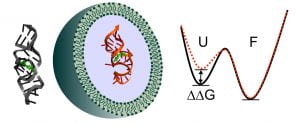RNA is widely agreed to be an early, if not the earliest, molecular basis for life. However, conditions on the early Earth were not terribly hospitable. While high-energy photons are important for prebiotic synthesis, they also damage nucleic acids. Postdoctoral fellow Ranajay Saha characterized the effect of UV radiation on functional RNAs. Lesions were spread quite unevenly across the sequence, with binding pockets being particularly susceptible.
On the ‘bright’ side, RNAs might find some relief by sheltering inside membrane vesicles. Dr. Saha’s earlier work demonstrated that encapsulation inside vesicles increases the activity of RNAs, countering the generally denaturing effect of lipids. Thus, although vesicles depress the activity of RNAs on the outside, those RNAs that are lucky enough to be encapsulated obtain an advantage. These biophysical effects might create interesting evolutionary consequences.
Saha R and Chen IA. Effect of UV radiation on functional and templating ability of fluorescent RNA aptamers. ChemBioChem, 20.
Saha R, Verbanic S, Chen IA. Lipid vesicles chaperone an encapsulated RNA aptamer. Nat. Commun. 9:2313

